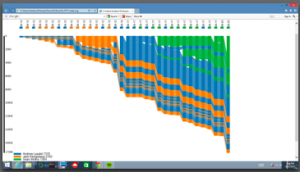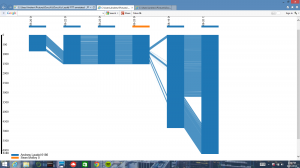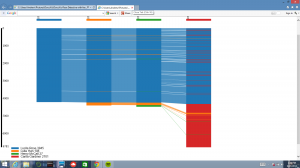



Andrew Laudel (24 Aug. 2014)
Overview: Students use the Google Docs revision history tool and DocuViz visualization maps, a revision history visualization tool developed by Judith Olson and other researchers at the University of California Irvine in collaboration with Google, to graphically depict and meta-analyze their own patterns of contribution, collaboration, and revision.
Here is a sample assignment. Here is an explanation of several sample Docuviz maps for different writing projects.
Teaching Goals: This is a great new digital tool to visualize the writing process of single author or collaborative documents. It is also a powerful way to demonstrate to students that data deleted from google docs is not actually deleted: it remains in meta-data form that can be retrieved, viewed and analyzed.
Theoretical Rationale: How do we encourage students to think critically about their writing choices, and how do we help them to understand the histories of the text they read and write? I aim to encourage richer, more evidence supported student reflection on their own work by asking students to use DocuViz mapping. The Google Docs revision history tool and DocuViz visualization map lay bare a document’s history by graphically depicting patterns of contribution, collaboration, and revision. By asking students to analyze and draw conclusions about their writing using these histories as evidence, students will improve their reflective writing, including their metacognition on the writing process and their understanding of how collaborations function effectively or break down.
In the NCTE Framework for Success in Postsecondary Writing, developed collaboratively by the Council of Writing Program Administrators, the National Council of Teacher of English, and the National Writing Project, metacognition is included as a habit of mind “crucial for college level learners”(4). Paul Prior, in his “Tracing Processes: How Texts Come into Being,” argues that this kind of metacognition can only be understood by carefully exploring the histories of texts (520). The DocuViz and revision history process analysis tools contribute to a body of established methodological tools that are already used by other researchers in the field of composition to study the writing process.
The writing process itself – what actually happens when writers write, how they come up with ideas and how they shape and grow those ideas in response to either internal or external feedback – has long been a topic of inquiry in the field of composition. Methods for process analysis have included talk-aloud protocols, a comparative analysis across drafts of the same piece (historical analysis of a text), and process logs (Prior). By introducing students to a body of metadata – data about their own writing process and choices – they will have the opportunity to see their choices more concretely as a source for developing and supporting their reflective thinking. This data will inform students’ analysis of their writing process.
This focus on collaboration and process analysis supports the course goals of English 120. In particular, this project supports students’ pursuit of course goal 2 by providing them with a specific set of tools and guidelines to “cultivate a critical, reflective, and recursive approach to reading, writing, and research that uses writing to learn.” It also advances student mastery of course goals 3 and 5 which explicitly call for the incorporation of feedback through global revision and the inclusion of a reflective essay in the final portfolio. Since revision is both the object of analysis and the subject of assessment in a reflective writing piece, this assignment scaffolds the final reflective essay in a useful way by providing students with multiple concrete methods for reflection and a body of written reflective work tracing their development as writers who think critically about their choices.
Works Cited
NCTE et al. Framework for Success in Postsecondary Writing. Urbana, NCTE. 2011. Web.
Prior, Paul. “Tracing Processes: How Texts Come Into Being.” What Writing Does and How It Does It. Eds. Charles Bazerman and Paul Prior. Mahwah, NJ: Lawrence Erlbaum, 2004. Print. Reprinted in Writing About Writing: A College Reader, 2nd ed. Eds. Doug Downs and Elizabeth Wardle. Boston: Bedford/St. Martins, 2014. 492-523. Print.

